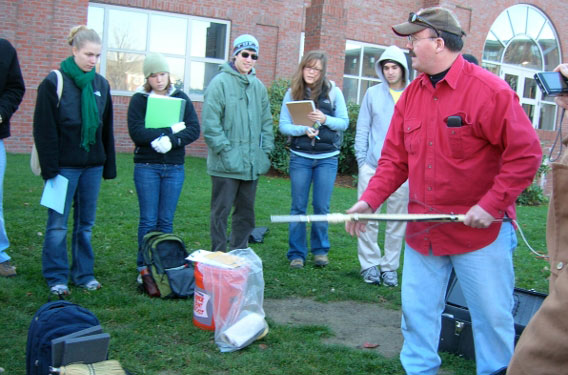Water World
A geologist and his students discover underground aquifer on campus
If you’ve walked along the College Avenue sidewalk by the Memorial Steps, you probably know it’s never easy to avoid a watery—or icy—mess on one short stretch. You might think it’s a perpetually burst pipe, as water seeps onto the sidewalk from the Hill. But last semester Grant Garven and his geology students found the real explanation—an unexpected body of water under the Hill on the Medford/Somerville campus.

Professor Grant Garven instructs students on using the water-monitoring equipment at one site on Tufts’ Medford/Somerville campus.
To give his students hands-on experience studying how water moves beneath the Earth’s surface, Garven, a professor of geology in the School of Arts and Sciences, had four boreholes drilled on campus last summer and fall. They hit paydirt 50 feet deep, in the form of a previously unknown aquifer, an underground reservoir of water mixed in gravel and sand. They call it “Jumbo’s Aquifer.” It’s responsible for the water seeping onto College Avenue, at the base of Capen Street near Winthrop and under the tennis courts along Professors Row.
In the specialized discipline of hydrogeology—the study of how water moves underground through soil and bedrock—it was a noteworthy find, because engineers had long ago ruled out the possibility of an underground water source in the area.
The boreholes were sited at different elevations. Garven’s first monitoring well, and the one that tapped the aquifer, was drilled behind the Olin Center at the highest elevation on Tufts’ Medford/Somerville campus. The other two wells were drilled at lower elevations, one near the Mayer Campus Center and the other near the Powder House rotary. Each borehole reaches between 120 to 200 feet deep. The installations, done by Cushing & Sons of Keene, N.H., were made possible by startup funding from the geology department and the School of Arts and Sciences.
Garven, who came to Tufts in 2007 after teaching for 25 years at Johns Hopkins University, says the aquifer is just the type of discovery that will enhance his students’ understanding of hydrogeology. Most are majoring in geology or civil and environmental engineering. Under Garven’s direction, the students operate underground cameras, meters and other state-of-the-art equipment at the monitoring sites to map patterns of groundwater flow and record variations in temperature, chemical composition and pressure.
Installing monitoring wells on a university campus is not the usual way of teaching hydrogeology, of course. It’s easier to stick with textbooks or theoretical models, but having a borehole monitoring system outside the classroom door, so to speak, helps students translate theory into practice, says Garven.
He likens it to teaching someone how to drive. “One can learn, in theory, how to drive a car by reading books and watching DVDs, but the best way is to take driving lessons in a real car,” says Garven, who is also an adjunct professor in the Department of Civil and Environmental Engineering, and a faculty member of the Water: Systems, Science and Society graduate program.
It used to be that Garven had to take his class on field trips to places such as Otis Air Force Base on Cape Cod, where the federal government maintains monitoring systems to evaluate groundwater conditions as part of a pollution cleanup program there. “It was very time consuming—just getting there and back required a whole day, and access is limited,” he says. But now, the field trip is a short walk from the classroom.
But don’t count on Tufts’ campus becoming a new Poland Springs. The boreholes, Garven says, will be used for teaching purposes, not as a water source.


